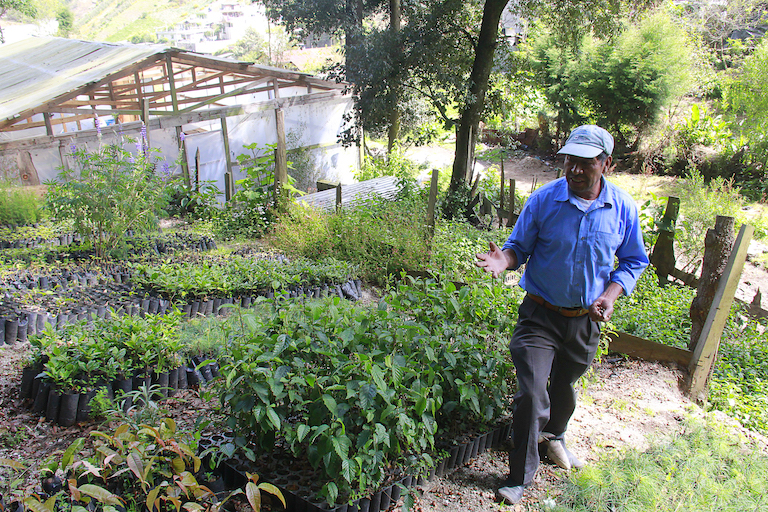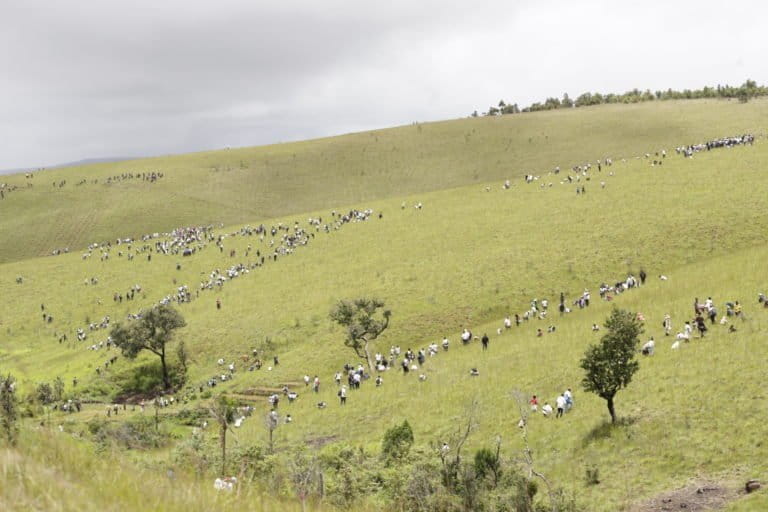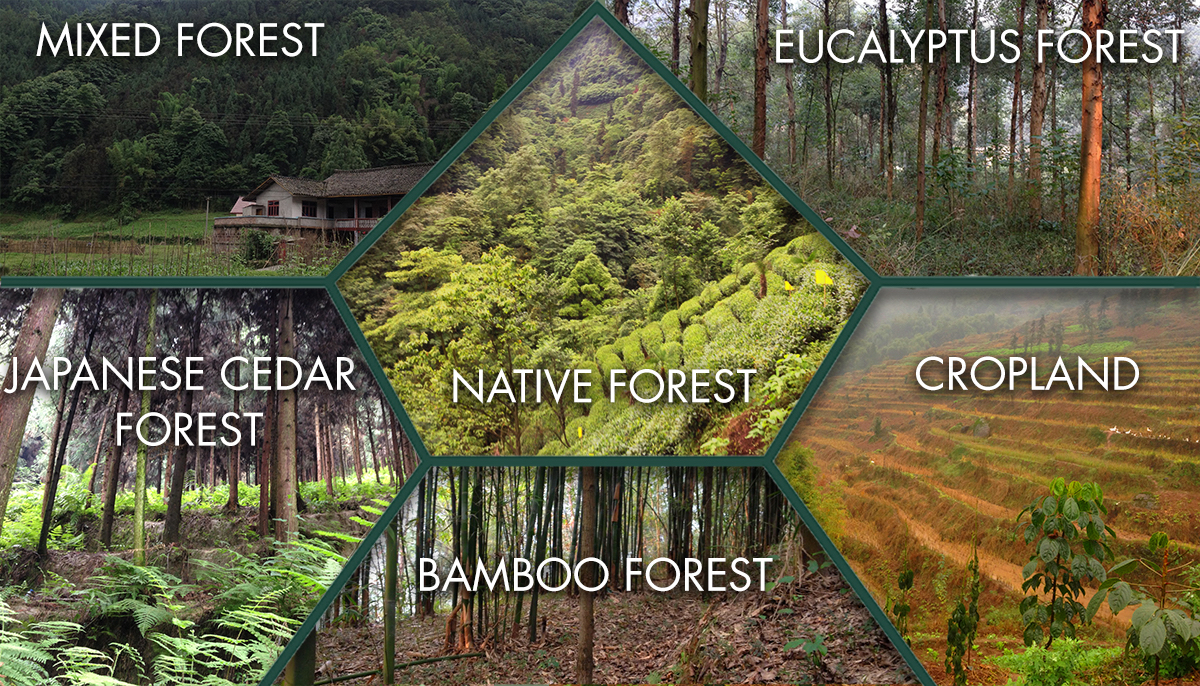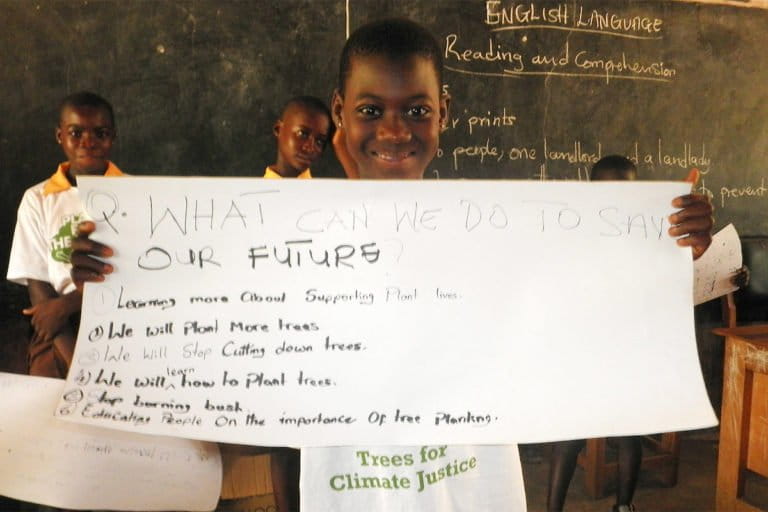- As the world searches for solutions to global climate change, tree planting has become increasingly popular, with ambitious campaigns aiming to plant billions or trillions of trees.
- These projects often have other environmental goals, too, like regulating water cycles, halting soil erosion and restoring wildlife habitat. They also often have socioeconomic goals, like alleviating poverty.
- But how effective is planting trees at accomplishing all this, and how strong is the evidence for this effectiveness? To find out, Mongabay engaged a team of researchers who conducted a non-exhaustive review of relevant scientific literature.
- We detail the results below, as part of Mongabay’s special “Conservation Effectiveness” series. Research by Zuzana Burivalova, Rodrigo Mendes and Sharif Mukul.
People have been planting trees to restock forests for a very long time.
In the 16th century, for instance, wealthy landowners in Britain and Europe established tree plantations to supply timber for shipbuilding. In the 13th century, Portugal’s King Afonso III had a pine forest planted, known as the Pinhal do Rei, to hold back encroaching sand dunes (and provide timber for the royal navy). In the 5th century, monks on the Adriatic coast reportedly planted a pine forest to supply themselves with fuelwood and food.
Even before these forests took root, Roman senator and historian Cato the Elder, who died in 149 B.C., recorded the planting of conifers to provide timber for ships. Earlier still, the Zhou Empire, which ruled China from 1100 B.C. to 256 B.C., created a forest service specifically dedicated to preserving natural forests and replanting cut forests. And there’s evidence that Indigenous peoples’ planting of domesticated species prior to the arrival of European settlers influenced the composition of the Amazon Rainforest we know today far more than researchers previously realized.
These are, essentially, early examples of tree planting aimed at supplying some service or product. Tree planting as a means of replacing functional native forests is a much more recent endeavor. “Reforestation in terms of ecological restoration, that is, reestablishing forests that will be similar to their previous ecological state, is a relatively recent ambition for Western society,” Kate Hardwick, a conservation scientist at the Royal Botanical Gardens, Kew, told Mongabay, “although it has been practiced by Indigenous communities for thousands of years.”
As recently as 20 years ago, we knew little about how to cultivate most tree species on a large scale, according to Robin Chazdon, a research professor of tropical forest restoration at Australia’s University of the Sunshine Coast. Some countries, like Brazil, have “made really great strides” learning how to collect millions of native seeds, store them, and grow seedlings with sufficient root development to survive once they are out-planted, while others still lag, she said.

Today, as the world searches for solutions to global climate change, tree planting has become more popular than ever. It’s a simple and appealing response to an overwhelming, existential crisis, and it makes for easy messaging: anyone can go out and plant a tree to help restore balance to Earth’s climate. But for many large-scale tree-planting initiatives, the focus is on the number of new trees that end up in the ground, not on planting the right trees in the right places or caring for them after planting to ensure they survive.
While mitigating climate change is the chief driver of many tree-planting initiatives, these projects often have other environmental goals, too, like regulating water cycles, halting soil erosion and desertification, and restoring wildlife habitat. They also often have socioeconomic goals, like alleviating poverty and enhancing local communities’ health and livelihoods.
But how effective is planting trees at accomplishing all this, and how strong is the evidence for this effectiveness? To find out, Mongabay engaged a team of researchers who conducted a non-exhaustive review of relevant scientific literature. We detail the results below, and you can also explore the database of findings we collected via this interactive infographic.
Before looking at our results, though, it is necessary to explain what we mean by reforestation, because the term is widely used to describe different kinds of projects. Some reforestation projects aim to restore a previously existing or degraded forest ecosystem and they usually focus on planting native species or facilitating natural regrowth of the forest — activities that fall under the umbrella term of forest restoration.
But reforestation does not necessarily lead to forest restoration. For instance, planting monocultures of non-native species is a common form of reforestation, but its end point is very different from the original forest (think of a Christmas tree plantation). Sometimes, reforestation projects plant a mix of native and non-native species to both promote the restoration of the ecosystem and provide timber or other forest products that can boost local economies and reduce logging pressure in native forests. So, reforestation and forest restoration are closely related terms, but their precise definitions are still evolving and shift depending on who uses them and in what context.
For our purposes here, we define reforestation as planting trees to restock depleted or clear-cut forests, regardless of whether the resulting landscape is a monoculture plantation or a biodiverse forest ecosystem. By contrast, we define forest restoration as actively attempting to return an area to its previous naturally forested state; the priority is the recovery of a forest ecosystem, not just tree cover. In our database of findings, we included only research evaluating the effectiveness of projects that included tree planting, though they may also have employed other forest restoration measures, like clearing invasive species or remediating degraded soil.

Reforestation is the hot new trend in our warming world
Reforestation is increasingly popular amid growing recognition of the many convergent environmental crises we’re facing, from climate change to biodiversity loss and water scarcity. In fact, the urgency of restoring degraded forests and other ecosystems is such that the United Nations declared the years from 2021 to 2030 the U.N. Decade on Ecosystem Restoration.
One of the earliest examples of modern reforestation is the Green Belt Movement, founded by 2004 Nobel Peace Prize winner Wangari Maathai in Kenya in 1977. The movement has now planted more than 50 million trees to help restore the environment and alleviate poverty. Government-led projects like the Great Green Wall across 20 countries in the African Sahel and the Three-North Shelter Forest Program in northern China (also sometimes known as the Great Green Wall of China) have planted hundreds of millions of trees over the past few decades as a bulwark against desertification.
Meanwhile, big, high-profile NGO-led campaigns like the Trillion Tree Campaign, 1t.org, Trees for the Future, One Tree Planted, and Plant a Billion Trees have proliferated, most of them targeted at carbon sequestration to mitigate global warming and other environmental benefits. And companies like tech giant Microsoft and Italian oil company Eni are planting trees to offset their greenhouse gas emissions.
Click here to learn about Mongabay’s tool for evaluating the transparency of tree planting projects.
Institutions around the world are committing to restore forests and other natural ecosystems under the auspices of various international agreements as well. The Bonn Challenge, for instance, launched in 2011 by the German government and the International Union for Conservation of Nature (IUCN), has recorded pledges by governments and NGOs in 60 countries to restore 210 million hectares (nearly 520 million acres) of land, with the ultimate goal of restoring 350 million hectares (865 million acres) by 2030. Reforestation and forest restoration also factor into many countries’ plans for meeting the emissions reduction targets they committed to in ratifying the Paris climate agreement.
The tree-planting boom has been bolstered by research at times, such as a 2019 study that estimated there is room to plant 900 million hectares (2.2 billion acres) with trees in areas across the globe that are naturally suited to supporting forests and woodlands. Planting these new forests could store as much as 205 billion metric tons of carbon, about 25% of the carbon human activities have released into the atmosphere to date, the study found. “This highlights global tree restoration as one of the most effective carbon drawdown solutions to date,” it says.
While planting trees would seem to have clear, unmitigated benefits, the reality is not so simple. In fact, that 2019 study was heavily criticized for, among other things, ignoring local conditions in many of the areas it identified as suitable for restoration. There are a number of complex factors that have to be considered to determine where, when, and what kind of tree planting is warranted.
“Today reforestation projects are basically only concerned with the number of trees planted. It’s like it’s the end goal,” Pedro Brancalion, a professor at the University of São Paulo who is both a forest restoration researcher and practitioner, told Mongabay. “But the number of trees you planted is just the start of a long-term process.”

Reforestation projects can fail to achieve their intended results if not planned properly. A 2017 study of mangrove forest restoration initiatives in Sri Lanka found that, at nine out of 23 project sites, not a single lanted tree survived. Just three sites had more than half the trees survive and, in the end, only about one-fifth of the more than 1,000 hectares (almost 2,500 acres) planted successfully recovered as healthy mangrove ecosystems.
There are also documented cases of tree planting having unintended and even negative environmental consequences. Starting in the 19th century, South Africa began planting non-native Australian acacias to stabilize dunes and produce timber. But the acacias quickly spread across wide swaths of South Africa’s native grasslands and heathlands, lowering the water table and reducing water availability. The country now spends millions of dollars every year to remove the troublesome trees. “That’s a clear example of where exotic species used in monoculture plantations got out of hand, became invasive, and caused problems,” Kate Hardwick said.
Reforestation programs can negatively impact people’s livelihoods, too. Pakistan’s “10 Billion Trees Tsunami” program reportedly led to tenants being evicted from their land by landowners looking to establish tree plantations, and also lost more than $3 million due to corruption.
We could learn a lot from problems like these, but scientific analyses of them are rare. We ultimately have no way of even knowing how many reforestation projects have failed outright. “I think the main knowledge gap is that we don’t know the level of success of restoration projects, because usually people only report results and have data on successful projects,” Brancalion said. Resources that go into planting the wrong trees in the wrong place are wasted and would have been better spent on a different intervention, he added.

Lessons from a mega-reforestation project
China’s Grain for Green program is instructive in a number of ways.
In response to a series of devastating floods in the late 1990s that killed more than 4,000 people, the Chinese government embarked on the most extensive tree-planting effort the world had ever seen. The Grain for Green program (GFGP) launched in 1999 with the primary goals of mitigating flooding, reducing soil erosion, and boosting the livelihoods of the rural poor in western China. Employing a payments-for-ecosystem-services scheme, the government provided households with technical support, cash and food in exchange for planting trees in areas of degraded farmland, especially those most prone to landslides and erosion.
Based on its primary goals of reducing erosion and runoff, the GFGP has been a success. As of 2019, the project cost roughly $73 billion and participants had planted trees on 32 million hectares (79 million acres) of cropland and barren scrubland. Today, more than 23% of China’s landmass is covered in trees, up from 19% in 2000. A 2012 study found that “runoff decreased and the soil erosion significantly decreased because of an increase in the area of farmland-converted forestlands.” Many of the trees provide timber, fruit and other forest products, enhancing the livelihoods of local communities. And while mitigation of global climate change was not a principal target of the program, research showed the GFGP “largely increased” soil organic carbon stocks.
But overall, the results of this ambitious reforestation effort have been decidedly mixed, even prompting assertions that China’s new “forests” aren’t really forests at all. A 2018 study led by Beijing University’s Fangyuan Hua while she was at the U.K.’s University of Cambridge determined that, as of 2015, gross tree cover had grown by nearly a third, with 1,935 square kilometers (747 square miles) newly treed. However, that increase was due almost entirely to degraded farmland being converted into monoculture tree plantations of one single species like bamboo, eucalyptus, or Japanese cedar.

Despite all of the tree planting, Hua and her team found that native forests had declined by 6.6%, or some 138 km2 (53 mi2), at the same time. “Thus, instead of truly recovering forested landscapes and generating concomitant environmental benefits, the region’s apparent forest recovery has effectively displaced native forests, including those that could have naturally regenerated on land freed up from agriculture,” Hua and co-authors write in their study.
Hua told Mongabay that the native-forest loss resulted at least in part from people exploiting a loophole in China’s forestry regulations to make way for plantations. She added that the Chinese government rectified the situation after Greenpeace East Asia pointed out that people had illegally cleared 1,295 hectares (3,200 acres) of natural forest inside key giant panda sanctuaries.
Tree plantations, of course, cannot compare to native forests in terms of their capacity to support wildlife like pandasand provide other ecological services. A few GFGP forests are what researchers call “compositionally simple mixed forests” containing two to five tree species, and these did experience modest gains in the number of bird and bee species compared to the cropland they replaced, according to a 2016 study that Hua also led. Monocultures, on the other hand, which comprise the overwhelming majority of GFGP forests, harbor fewer bird and bee species than croplands. Both monoculture and mixed-species reforested areas had lower bee diversity than croplands, the researchers found, probably due to the lack of flowers. And neither type of GFGP forest had anywhere near the biodiversity of native forests.
“So far the argument has been that plantations are effective at curbing soil erosion, and to a large extent I think studies show that,” Hua told Mongabay. “But these studies tend not to have evaluated the soil erosion performance as compared to a proper reference benchmark, like native forest, which we have been thinking about as biodiversity specialists.”
Lack of biodiversity is not the only environmental shortcoming of China’s GFGP. Researchers found that many of the non-native tree species that were planted require more water than native vegetation, meaning GFGP forests are sucking up more rainfall and reducing the amount of runoff to rivers. This was, of course, a desired outcome of the program. But as global warming leads to an increasingly drier climate, water shortages could, ironically, become a problem in a region that suffered devastating floods as recently as 1998. Another study even explicitly warned against continuing the GFGP for this very reason.
The involvement of multiple stakeholders, especially local community members, was one of the bright spots in the program’s design. There is evidence that the program increased incomes, though those benefits don’t always appear to have been evenly distributed, and in some regions richer households were found to have had greater access to the program than poorer households. As simple a change as promoting mixed forests instead of monocultures could have improved biodiversity outcomes, researchers say, without undermining the achievements.

How to plant a forest: Context is key
Experts have generally come to agree that the first step in restoring any forest is to ensure that the underlying causes of forest destruction in the area, and ideally surrounding forest as well, have stopped. This isn’t necessarily easy to accomplish. Robin Chazdon and colleagues point out in a 2020 study that many replanted or naturally regrowing forests have no legal protection. But in addition to protecting the time and money invested in a project, there’s a strong ecological incentive to doing so: “All young forest will need the assistance, the biological assistance, of forest remnants, and we have to be sure that these remnants will be in a good situation to contribute to the restoration,” Brancalion said.
The next steps involve working with all stakeholders, and most crucially the local people who will have to live with the restored forest, to determine the project’s desired outcomes and the best approach for achieving those goals. One of the more important decisions to be made is whether or not active measures like tree planting are even necessary, as under certain conditions just protecting the land and letting forests regrow on their own, called natural forest regeneration, can be the cheapest and most effective solution. Other decisions include who will care for the restored forest and who will have access to the benefits it furnishes.
If tree planting is in order, Brancalion said that to get the benefits you want from a project, you have to be sure you’re planting the right trees in the right place. Trees that aren’t suited to the local climate, for instance, will have short lives, and trees that require too much water can deplete water tables, as in South Africa. “If you plant invasive trees, then you can sequester carbon, but you may do harm to biodiversity,” Brancalion said. “If you plant the trees in the wrong place, you may displace agricultural production, you may create economic problems for local landowners, you may destroy native biodiversity when you plant the trees in non-forest ecosystems.”

Because of the complex decision-making that must attend any successful reforestation project, Brancalion said he thinks negotiation is perhaps the most overlooked aspect. “Before planting any tree or making any field intervention, you have to negotiate, to engage people, to understand what may or may not work on that specific location,” he said.
Reforestation is a “context-dependent activity,” with no single approach suited to all areas, Brancalion said: “So in one particular condition, planting some exotic species with some native species to support firewood production for a village can be a super successful project, even though you may not have super high biodiversity. It depends on your end goals.”
As an example of successful context-specific reforestation, Brancalion cited a project he contributes to, the Black Lion Tamarin Conservation program, led by researchers at the Institute for Ecological Research (known by its Portuguese acronym IPÊ). The black lion tamarin (Leontopithecus chrysopygus) was listed as critically endangered on the IUCN Red List of Threatened Species in the 1970s. The primate’s population had dwindled to just 100 individuals due to fragmentation of its only known habitat in Brazil’s Atlantic Forest by heavy agricultural activity. After the conservation program restored a 1,000-hectare (2,500-acre) forest corridor between two important remnants of Atlantic Forest, however, the black lion tamarin population rebounded to about 1,800 individuals, and the IUCN upgraded the species’ conservation status to “endangered” in 2008.
According to IPÊ, the program also engaged thousands of rural community members and landless families who had recently settled in the area. Researchers have found that, not only was the engagement of locals crucial to the program’s success, but people benefited from the program just as much as wildlife. A 2020 study showed that by growing and planting trees and participating in other conservation-related activities, “Farmers gained knowledge, income and food security, and developed a sense of ownership and shared responsibility for protecting wildlife, conserving forest fragments and restoring forests.”
The fact that community engagement and support for local livelihoods was baked right into the plan for the Black Lion Tamarin Conservation program is key to its success. Get the planning process wrong, though, “and then it doesn’t matter how many trees you plant, because most of them will die, and in some cases if they survive they can do more harm than good,” Brancalion said.

What the science says about how well tree planting works
Mongabay launched the Conservation Effectiveness series in 2017, collating the scientific evidence for how well a variety of common strategies actually work, including terrestrial and marine protected areas, forest certification, community-based forest management, and payments for ecosystem services. (You can find the current databases of research for all the interventions at ConservationEffectiveness.org and Mongabay’s stories about them here.)
In our Reforestation and Forest Restoration database, we collected scientific findings about the effectiveness of projects that include at least some tree planting. We excluded studies that focus on silvicultural measures, such as tree thinning and liana cutting, even if they may lead to faster forest regeneration. Likewise, we excluded studies focused on forest rehabilitation or agroforestry (the planting of trees alongside food crops), and those focused on natural regeneration, because many studies of tree-planting projects use natural regeneration as a control.
We are using a crowd-sourced approach to gather published, peer-reviewed scientific findings to include. To seed the database, several scientists added findings according to their own snowballing techniques, in which they would read a relevant publication and follow the references in it to find more relevant publications. We also had an entire class of undergraduate students at the University of Wisconsin–Madison add one publication each as an assignment for their “Forests of the World” course. An editor checks whether the individual researchers or students added the findings according to Conservation Effectiveness standards. This approach is not exhaustive, but it yielded 66 studies so far, of variable scale and rigor. Our research team examined these to determine how effectively reforestation projects deliver on a variety of environmental and socioeconomic outcomes.
We have now opened the reforestation and forest restoration database, as well as those of the other strategies on the platform, so anyone can contribute additional research, subject to the same editorial process.

There are some important caveats to note about the body of available reforestation research. One is that failed projects are rarely reported or publicized; another is that even evidence of success may not be reported if the project itself didn’t include robust monitoring and reporting standards; and finally, many government-, NGO- and corporation-led projects have no obligation to report their results to anyone but the person or entity funding them. The upshot is that many reforestation efforts aren’t examined in peer-reviewed studies and hence our literature review most likely misses the lessons to be learned from them altogether.
Another important caveat is that even a successfully restored forest can take decades or more to confer anything like the benefits of natural, old-growth forest. That means the benefits of more recent reforestation initiatives may have yet to fully materialize, so they would not be reflected in current studies. (What’s more, we may never find out if they do materialize, or even if the new forest survives more than a few years, because funding for reforestation projects rarely pays for long-term care or monitoring.)
Finally, the changes the studies attribute to the tree planting mean different things depending on whether a natural regeneration site, a pasture, or a mature forest serves as a control for comparison.
Read more about our methodology here; you can access all 66 of the studies we reviewed here, as well as any others that have been added since we published this story.















